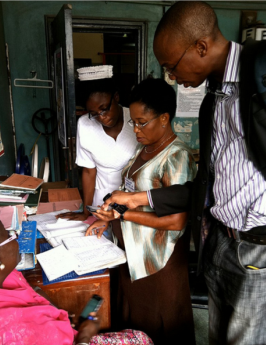Nigerians Scale Up Smartphones to Diagnose, Treat TB
Categories: Announcements, Where We Work

Supervisors using smartphone for supportive supervision at LGA facility.
Among people living with HIV, tuberculosis is a leading cause of death, especially in Africa. According to the World Health Organization, a person living with HIV is about 20 to 30 times more likely to develop active TB.
In Nigeria, the HFG project is supporting the scale up of smartphones to accurately diagnose and treat tuberculosis (TB). Health workers at more than 500 facilities are using smartphones, as well as androids, as a result of a successful pilot program that integrates these phones into the TB supervision process.
Nigeria has made significant progress in its fight against TB, but the National TB and Leprosy Control Program (NTBLCP) wanted to tap into mobile technology to provide more supportive supervision and improve health services, especially in areas with high defaulter rates, drug stock-outs, and TB/HIV services integration. USAID’s Health Systems 20/20 project collaborated with NTBLCP’s training center to develop a standard, integrated TB supervision checklist to assess and monitor diagnostic laboratories and Directly Observed Treatment Short course (DOTS) services and then piloted it in 16 facilities using personal digital assistants or PDAs. Based on the success of the pilot in four states, the program was scaled up to 200 facilities.
Under the Health Finance and Governance (HFG) Project, the program has since scaled up to an additional 300 facilities and upgraded from PDAs to smartphones. By using smartphones on their facility visits to collect TB data, supervisors have eliminated the need for printed forms, minimized human error in data entry, reduced the lag time for getting data to policymakers and managers, and helped pinpoint ways to improve the quality of care. There has also been considerable clinical impact as seen in results from Lagos and Abia States.
In Abia, the percent of TB- and HIV-positive (co-infected) patients on cotrimoxazol preventive treatment (CPT) jumped from 34 percent to 100 percent in one year. In Lagos, the percent increased from 33 percent to 57 percent during the same time period. Defaulter rates in both states have also declined considerably.
In areas with declines rather than improvements, the new system allows HFG staff to go back into the phone or database and pinpoint the causes, meaning quality improvement can be driven by evidence. As a result, solutions can be tailored to address the root causes of the issues. Given the program’s rapid growth from 16 facilities to more than 500 in only 2.5 years, mobile technology is clearly a powerful tool to improve the quality of care and to strengthen health systems.



